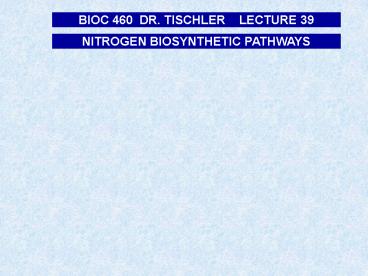NITROGEN BIOSYNTHETIC PATHWAYS PowerPoint PPT Presentation
1 / 12
Title: NITROGEN BIOSYNTHETIC PATHWAYS
1
BIOC 460 DR. TISCHLER LECTURE 39
NITROGEN BIOSYNTHETIC PATHWAYS
2
OBJECTIVES
- Outline the pathways for synthesis of the
following nonessential amino acids by
identifying the primary source of the carbons
and the nitrogen for their synthesis (alan, arg,
asp, glu, gln, and tyr) in humans. - General role of cofactors-derived from folic acid
and how these are important in metabolism of ser,
gly, met and cys - Discuss significance of S-adenosylmethionine in
"one-carbon" metabolism
3
OBJECTIVES (cont.)
- Identify two specific cofactor forms of vitamin
B12 and list the amino acids whose metabolism
depends on each form. - Concerning heme synthesis
- a) describe the reactions involved in the
formation of porphobilinogen - b) discuss the key features of its regulation
- c) explain why lead poisoning would affect the
oxygen carrying ability of the blood. - List the steps in the catabolism of heme to
conjugated bilirubin and identify the general
condition associated with the accumulation of
bilirubin in the body.
4
Figure 1. Synthesis of the nonessential amino
acids alanine (A), arginine (B), aspartate (C),
glutamate (D), glutamine (E), and tyrosine (F).
5
glycine synthase
Figure 2. Synthesis of the nonessential amino
acids asparagine, serine, glycine. CH2-THF is
methylene tetrahydrofolate
6
CH3
CH3
CH3
Methionine-CH3
CH3
CH3
Figure 3. Metabolism of CH3-THF, CH3-Cbl, met and
cys.
7
Table 1. Summary of the roles of folate and
cobalamin in nitrogen metabolism
Cofactor Vitamin precursor Role
Methyl-cobalamin Cobalamin (vitamin B12) methionine metabolism
Adenosyl-cobalamin Cobalamin (vitamin B12) isoleucine/valine metabolism
Methylene-tetrahydrofolate Folic acid serine/glycine metabolism
Methyltetrahydrofolate Folic acid methylcobalamin formation
Tetrahydrofolate Folic acid thymidine biosynthesis
8
?-Aminolevulinate synthase pyridoxal phosphate
MITOCHONDRIA
CYTOPLASM
Aminolevulinic acid dehydratase zinc-containing
enzyme Pb-sensitive
Figure 4. Pathway for synthesis of heme
9
REGULATION OF HEME SYNTHESIS
- Heme
- inhibits activity of pre-existing ?-ALA
synthase
- diminishes transport of ?-ALA synthase from
cytoplasm to mitochondria after its synthesis
- represses the production of ?-ALA synthase by
regulating gene transcription.
10
TEETH FROM PATIENT WITH PORPHYRIA DISORDER
11
PATIENT WITH PORPHYRIA DISORDER
12
BLOOD CELLS
KIDNEY
INTESTINE
LIVER
Figure 5. Catabolism of hemoglobin

